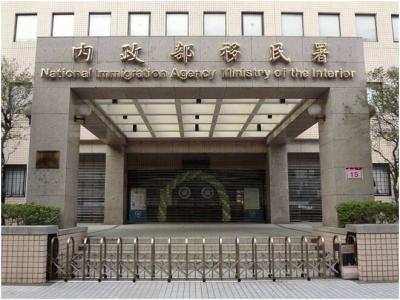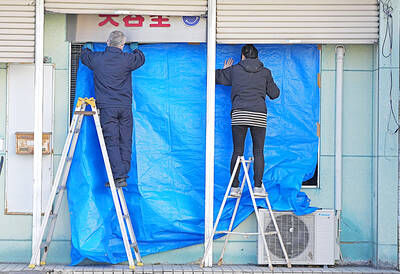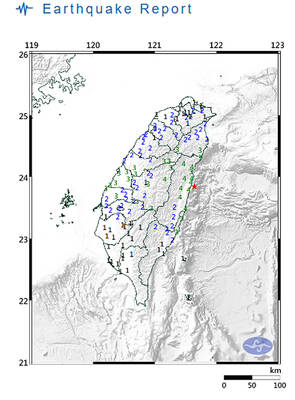The Central Epidemic Command Center (CECC) yesterday reported a new case of COVID-19, a Taiwanese woman who returned from the Philippines, while the Centers for Disease Control (CDC) urged people to avoid mosquito bites, as the risk of indigenous dengue fever is rising.
CDC Deputy Director-General Chuang Jen-hsiang (莊人祥), the CECC’s spokesman, said that the new case is in her 50s and lives permanently in the Philippines.
The last record of her leaving Taiwan is in January and she returned to Taiwan alone on Sunday, Chuang said.
On arrival in Taiwan, the woman reported having a fever since Thursday last week, but did not consult a doctor, he said, adding that she had a slightly high body temperature of 37.7°C, coughing, phlegm and sore muscles, he said.
The woman was taken to a centralized quarantine facility after receiving a COVID-19 test at the airport and yesterday was transferred to a hospital for treatment after a positive test result, Chuang said.
Health authorities are identifying the passengers who sat close to her on the flight to Taiwan, he said.
Asked about comments by National Taiwan University College of Public Health vice dean Tony Chen (陳秀熙), who said that a Belgian in Taiwan confirmed to have COVID-19 last week likely contracted the disease in Taipei in late June, Chuang said that real-time reverse transcription polymerase chain reaction tests had been conducted on 441 people who had close contact with the Belgian, with 366 people testing negative and 75 results not yet available.
Antibody tests were also conducted on the 441 people, with 382 returning negative results, he said.
“We have not determined whether the case is imported or domestic, but we will collect all the information we can and bring it to the CECC’s advisory specialists’ panel for discussion,” Chuang said.
Asked whether the CECC would consider requiring all visitors to Taiwan, or alternatively visitors from areas with higher infection rates, to be tested for COVID-19, as some public figures have suggested, Chuang said that mass testing might not be particularly beneficial.
With all travelers from the Philippines required to be tested upon arrival since July 26, 183 had been tested as of Sunday, he said.
Among those 183, 20 had symptoms and seven tested positive, while one — case No. 471 — tested negative at the airport, but later reported symptoms and tested positive in the second test at a hospital, Chuang said.
This shows that mass testing can still miss cases, he said.
Although 163 of the 183 people had no symptoms, two of them tested positive, including one (case No. 466) who is the spouse of another confirmed case with symptoms (case No. 467), he said.
These cases would have been detected through contact tracing and within a 14-day quarantine and additional seven-day self-health management period, he said.
Meanwhile, CDC Epidemic Intelligence Center Director Liu Ting-ping (劉定萍) said that five new cases of indigenous dengue fever were confirmed last week, including four in Taoyuan and one in New Taipei City, bringing the total confirmed cases of locally acquired dengue to 14 this year.
Dengue fever is at its peak in Taiwan and Southeast Asian nations, including Singapore, Thailand, Malaysia, Indonesia and Vietnam, Liu said, adding that people should be aware that the disease is a risk in northern Taiwan.

A small number of Taiwanese this year lost their citizenship rights after traveling in China and obtaining a one-time Chinese passport to cross the border into Russia, a source said today. The people signed up through Chinese travel agencies for tours of neighboring Russia with companies claiming they could obtain Russian visas and fast-track border clearance, the source said on condition of anonymity. The travelers were actually issued one-time-use Chinese passports, they said. Taiwanese are prohibited from holding a Chinese passport or household registration. If found to have a Chinese ID, they may lose their resident status under Article 9-1

Taiwanese were praised for their composure after a video filmed by Taiwanese tourists capturing the moment a magnitude 7.5 earthquake struck Japan’s Aomori Prefecture went viral on social media. The video shows a hotel room shaking violently amid Monday’s quake, with objects falling to the ground. Two Taiwanese began filming with their mobile phones, while two others held the sides of a TV to prevent it from falling. When the shaking stopped, the pair calmly took down the TV and laid it flat on a tatami mat, the video shows. The video also captured the group talking about the safety of their companions bathing

PROBLEMATIC APP: Citing more than 1,000 fraud cases, the government is taking the app down for a year, but opposition voices are calling it censorship Chinese Nationalist Party (KMT) Chairwoman Cheng Li-wun (鄭麗文) yesterday decried a government plan to suspend access to Chinese social media platform Xiaohongshu (小紅書) for one year as censorship, while the Presidential Office backed the plan. The Ministry of the Interior on Thursday cited security risks and accusations that the Instagram-like app, known as Rednote in English, had figured in more than 1,700 fraud cases since last year. The company, which has about 3 million users in Taiwan, has not yet responded to requests for comment. “Many people online are already asking ‘How to climb over the firewall to access Xiaohongshu,’” Cheng posted on

A magnitude 5.7 earthquake yesterday struck off the coast of Hualien, causing brief transportation disruptions in northern and eastern Taiwan, as authorities said that aftershocks of magnitude 5 or higher could occur over the next three days. The quake, which hit at 7:24pm at a depth of 24.5km, registered an intensity of 4 in Hualien and Nantou counties, the Central Weather Administration (CWA) said. There were no immediate reports of damage or injuries. In Taipei, the MRT railway’s operations control center received an earthquake alert and initiated standard safety procedures, briefly halting trains on the Bannan (blue) line for about a minute.